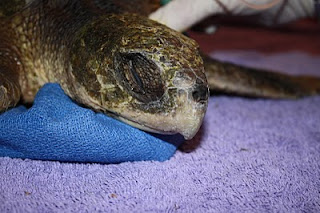
Voyageurs #30 was found by the Smithsonian's article writer Amy Sutherland.
The writer of the article, Amy Sutherland, spent part of a day with both groups to see the process first hand. She did a "ride along" of a beach rescue and initial intake at the Mass Audubon at Wellfleet Bay, and then a road trip to the NEAq to start the medical care of the turtles. Amy found #30 Voyageurs!


Above Voyageurs is getting some fluid therapy to help with electrolyte imbalance.
After three weeks of care, Voyageurs headed north with a handful of other turtles. Many are still continuing their rehabilitation at The University of New England's Marine Animal Rehabilitation Center. We then continued to get more turtles almost daily. As the article states more turtles were moved to other centers and we currently have 28 sea turtles still at the Aquarium in the Sea Turtle Recovery Room - 25 Kemp's ridley and 3 green sea turtles.
The article was a great snapshot and overview of some of the work the stranding organizations do for these turtles, as well as conservation issues that have and still face these turtles. It is a great article for sea turtle medical care and conservation!


Oh by the way... Mentioned in the article was a nesting sea turtle. Found these photos in our archive of the turtle "Hatchet Head" Harry. Lovingly referred to that way because of the injuries to his/her head. Obviously, at the time we did not know the sex of the animal. It was awesome to find out the turtle had nested and is no longer Harry but Harriet!
-Adam






